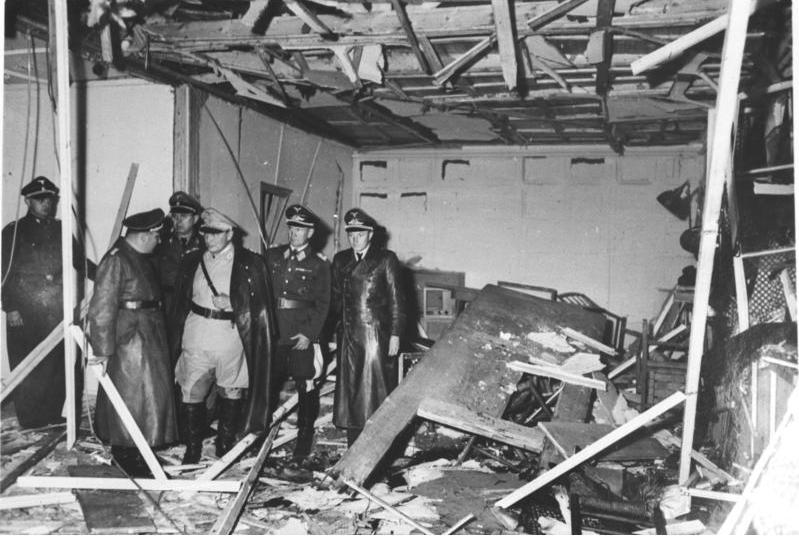July 20, 1944, 80 years ago: Operation Valkyrie is carried out. The intention is to kill Chancellor Adolf Hitler of Nazi Germany. It is not successful.
A previous attempt to kill him was made on November 8, 1939, in Munich, as Hitler was celebrating the anniversary of the Beer Hall Putsch, the Nazi Party's failed attempt to take over the government of the German state of Bavaria in 1923. Hitler left earlier than expected, so he was not among the 8 people killed by a bomb planted by Georg Elser.
Elser was quickly found and imprisoned. With some irony, not only was he not executed immediately, but he outlived many of the 1944 plotters -- and almost outlived Hitler anyway, only being executed at the Dachau concentration camp on April 9, 1945.
By July 1944, on the Western Front, the Allies had made their D-Day invasion, and were rolling through France. On the Eastern Front, the Soviets had pushed Nazi troops out of their country. For the first time, it was clear that Germany was losing the war.
Generals begged Hitler for trains, to move troops and equipment to the fronts. Hitler said, "No, I need the trains to kill the Jews." In other words, to transport them to the concentration camps. So the generals knew that the thing that would most help them in the war was not coming.
So a plot was hatched to remove Hitler from power. And since he had been granted absolute power by the Reichstag years earlier, the only way to do that was to kill him. The hope was that the successor government would then be able to make peace with the Allies, and that Germany would be able to keep what it still had by that point.
The plotters had an inside man. Colonel Claus von Stauffenberg was an aide to the senior staff of the Germany Army, the Wehrmacht. Hitler had scheduled a meeting of the senior staff for his retreat, the Wolfsschanze (Wolf's Lair) in Rastenburg, East Prussia, for July 20.
Stauffenberg walked into the briefing room carrying a briefcase containing two small bombs. But he only had time to arm one of the bombs. He left the briefcase under the conference table, as close to Hitler as he could get it. Then, as part of the plan, someone walked in and told Stauffenberg that there was a phone call for him. He excused himself, and left the room.
At 12:42 PM, Stauffenberg looked back, and saw the explosion and the smoke. He presumed that Hitler was dead. He got into a staff car, driven by his aide Werner von Haeften, and left the Wolfsschanze complex for the nearby airfield. By 1:00, he was airborne, with a plane whose flight was arranged by another conspirator.
At 4:00, Stauffenberg's plane landed at Berlin's Templehof airport, and he called the Bendlerblock, the Nazis' version of the Pentagon, telling them that Hitler was dead. This was his biggest mistake: It immediately made him something he had not been before the call: A suspect.
Had he waited for confirmation -- or, as it turned out, for denial -- he might not have become a suspect. Becoming one was bad for him, because Hitler was alive. When Stauffenberg left the briefing room, Colonel Heinz Brandt moved the briefcase. As a result, while the explosion did kill 4 people and injure almost everyone else in the room, Hitler was shielded by a leg of the solid oak conference table. Shrapnel ripped through his pants, giving him minor wounds to his legs. And, like almost everyone else in the room, Hitler suffered a perforated eardrum. But that was the extent of his injuries.
The Gestapo ended up arresting more than 7,000 people, executing 5,000 of them, including Stauffenberg, shot by a firing squad the next day. Field Marshal Erwin Rommel was a part of the plot, but, as Germany's greatest living military hero, he was given the option of suicide, and the use of a cover story that he had died in battle, which would protect his name and his family from dishonor.
The Allies continued closing in, and Hitler lasted another 9 months before taking the easy way out. The Soviets attempted to destroy the Wolfsschanze, but it was so solidly reinforced that conventional explosives couldn't do the job. The remains are now a historic site, and the redrawing of national borders after the war means that they're now located in Kętrzyn, Poland.


No comments:
Post a Comment